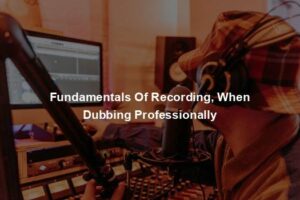
WHAT IS MIXING?
Mixing is the bending of all the individual tracks in a recording to create a finished version.
WHAT IS AUDIO MIXING IN DUBBING?
Audio mixing entails blending recorded audio tracks together to create a channel. Aspects of volume levels and frequencies are put into consideration. Mixing in dubbing is putting the recorded audio together, matching the music and effects to create a complete movie that is the same as the original. This process puts into consideration the aspect such as volume levels and frequencies.
It is a very important stage in dubbing. This is the ultimate stage that gives you a final feel of the dub.
STEPS TO FOLLOW TO GET A GOOD DUB MIX.
A good professional mixer will follow these steps to ensure that the end product of their mix is amazing. These are the premixing steps.
PREMIXING STEPS
1. WATCH THROUGH THE ENTIRE FILM THAT YOU ARE MIXING.
Watching the original film before you start your mix is very important because this will give you an overview of what the entire film is about and what you should expect in mixing. This will help you know the techniques you will use to attack your mix.
2. CLEANING AND LEVELING.
This part is so important. Files or audio tracks recorded in the studio may have some breath, cough, or unwanted talks in the middle of the recording. Cleaning will give you clear audios, just exactly what you want to use.
As you clean, you also level your audio to ensure all of them are on the same level or the level you would prefer to use. This will help you have a balanced volume of your audios.
3. MARKING YOUR SESSION.
This is a very important aspect of mixing. When a session has a marker, it helps the mixer know the important places where what is required. This gives the mixer an easy time when mixing.
What do you check when marking? When marking your session you check on where events are happening, the outdoor events since they need to have a different feel from the indoor ones. Mark if it the rooms, halls, fields, the phone effects, television scenes…. Etc.
Once you are done with your premixing steps you are now ready to start your mix. Mixing a dub is not very hard though one can make it hard if they do not follow the following steps well. There are various things to check when mixing a dub.
MIXING STEPS
- When mixing your dub ensure you still recheck your sync and ensure it adheres to the standards of your client. Sync during mixing does not just focus only on the recorded audio, but the audio clips plus the music and effect. Ensure they are all in synch that is events asynchronous with the sound or the vice versa.
- The levels. Ensure your levels are well balanced. The music and effects should not overwhelm your dialogue. Ensure your effects are not too loud for your audiences’ ears. As you know every client has his or her own requirements of loudness, ensure you are meeting their requirements… when mixing listen and don’t depend on the loudness plugin. If you listen, you will be able to make a faster correction compared to if you look at your loudness metering, this will end up making you a slave to your plugins and a poor mixer. You can however use them just to cross-check your work.
- Effects. Ensure you have captured all the effects as needed. This will give your mix a test. Imagine a person watching and one is on the other side of a call but sounds the same as the one on-screen. Sounds bad, doesn’t it? Putting effects to the sound will give your mix a test that will draw your audience closer, and even like to watch more. It makes your dub appear real.
WORKING YOUR AUDIO IN MIXING FOR DUBBING
Working on your audio in dubbing is making your recorded audio sound exactly as they are recorded where the event was happening. This may be challenging if you don’t know what you need in the end. This is also very important as it makes your audio clear and clean.
1. EQUALIZING (EQ)
This is removing unwanted frequencies in your audio. Equalizing removes the roominess in your recorded audio. There are various plugins that you can use to Equalize your audio.
2. COMPRESSION
This helps to bring your audio levels clear and leveled. As much as compression is important, ensure that your audio is not so compressed since when you over-compress your audio may sound muffled.
3. REVERB
This is important to add some reverb in your mix since you don’t want your audio sound flat. In any normal conversation, there is some reverb in every place you are in. reverb is the depth of roominess in your location. This varies with the location where one is.
4. AUTOMATION
This now is ensuring every location of an event has it own sounding. Distance in your dialogue. This is changing reverb regarding distance. This is to ensure when one is in a hole and one on the field will sound different. Audio automation is very important. It will give the listener the feel to know where the event is happening. This may take you a lot of time to figure this and don’t rush to finish since wrong automation may change the whole feel of the whole dub.
When automating ensure you check:
a). The distance.- varied distance may have a different reverb. This is to mean someone on a cliff talking to someone down the cliff there is an aspect of echo in the dialogue because of the distance created. Putting this into consideration will give your mix a good feel.
b). location.- As I early said the location of where the event is happening matters a lot. An action happening in the room or hall will a different reverb compared to one happening on the field. This is very easy since all this are available on the pro tools and even other audio plug-ins
5. ROUTING YOUR MIX
This is channeling your dialogue and your m&e. this is the path you want your mix to follow. It varies with one choice of desire. Wrong routing may not give you a successful ultimate product.
- Channel your dialogue on one route first since they need to go through compression and other audio cleanings such as EQ. this is where you will channel your dialogue into the automation track which must be an aux track for automation. Every audio must be automated.
- Channel your music and effect differently. This is where you send your music and effects for limiting before sending it to a final track of mix where it is now combined with the dialogue to give you a mix dub.
- Create a receiving channel for both the music and effect and the dialogue. This is now where you can add your loudness metering to check your final loudness if you meet your clients’ demands.
CHALLENGES FACED IN DUB MIXING
1. LIP SYNCING
This is so challenging for a re-recording mixer if the recording casts are not around. During mixing the effect of lip-syncing is tightened. When the sync is off, it may be so hard for the mixer to fix and forced to use the Time Compression Expansion (TCE) tools to stretch or condense dialogue which might sound so unrealistic for a listener conversant with sound.
The sync in mixing is not just on dialogue only but also on the effects. This is so challenging especially if the m&e is a bit off synch. Synch the effect may challenge to the mixer and time-consuming.
2. LEVELS
Levels are all in mixing. They determine the end product of your mix. Well-recorded levels give the mixer an easy time in mixing but low and distorted levels are hard and demanding to deal with. For low levels, once the gain is increased the mix picks the white noise of the studio and thus giving poor sound in mixing. The loud or distorted ones can’t be corrected, thus wasting the mixer’s time as re-recording is inevitable.
3. MIXED CHARACTERS ON SAME TRACK
This is very challenging for a mixer to EQ two or more voices on one track. The EQ may not be to the standard and thus challenging the mixer at some point or even causing him or her to manually create tracks for each individual and then EQ them differently to get the best sound.
4. TIME
Time is always a challenging factor for mixers. When a dub is to be submitted mixers may not get enough time to do their mix procedurally as required. This challenges them and for them to achieve all the steps they might be required to work over the required time. Mixers’ time is so important to get the best end product in a dub.
NB: mixing is not hard one only needs to know what your client expects from you and make it happen.





